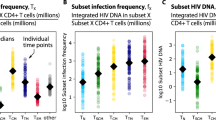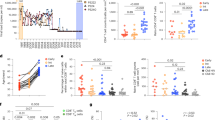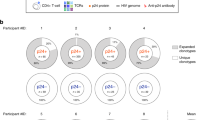Abstract
HIV persists in a reservoir of latently infected CD4+ T cells in individuals treated with highly active antiretroviral therapy (HAART). Here we identify central memory (TCM) and transitional memory (TTM) CD4+ T cells as the major cellular reservoirs for HIV and find that viral persistence is ensured by two different mechanisms. HIV primarily persists in TCM cells in subjects showing reconstitution of the CD4+ compartment upon HAART. This reservoir is maintained through T cell survival and low-level antigen-driven proliferation and is slowly depleted with time. In contrast, proviral DNA is preferentially detected in TTM cells from aviremic individuals with low CD4+ counts and higher amounts of interleukin-7–mediated homeostatic proliferation, a mechanism that ensures the persistence of these cells. Our results suggest that viral eradication might be achieved through the combined use of strategic interventions targeting viral replication and, as in cancer, drugs that interfere with the self renewal and persistence of proliferating memory T cells.
This is a preview of subscription content, access via your institution
Access options
Subscribe to this journal
Receive 12 print issues and online access
$209.00 per year
only $17.42 per issue
Buy this article
- Purchase on SpringerLink
- Instant access to full article PDF
Prices may be subject to local taxes which are calculated during checkout






Similar content being viewed by others
References
Palella, F.J. Jr. et al. Declining morbidity and mortality among patients with advanced human immunodeficiency virus infection. HIV Outpatient Study Investigators. N. Engl. J. Med. 338, 853–860 (1998).
Finzi, D. et al. Identification of a reservoir for HIV-1 in patients on highly active antiretroviral therapy. Science 278, 1295–1300 (1997).
Chun, T.W. et al. Presence of an inducible HIV-1 latent reservoir during highly active antiretroviral therapy. Proc. Natl. Acad. Sci. USA 94, 13193–13197 (1997).
Chun, T.W. et al. Quantification of latent tissue reservoirs and total body viral load in HIV-1 infection. Nature 387, 183–188 (1997).
Finzi, D. et al. Latent infection of CD4+ T cells provides a mechanism for lifelong persistence of HIV-1, even in patients on effective combination therapy. Nat. Med. 5, 512–517 (1999).
Hermankova, M. et al. Analysis of human immunodeficiency virus type 1 gene expression in latently infected resting CD4+ T lymphocytes in vivo. J. Virol. 77, 7383–7392 (2003).
Chun, T.W. et al. Relationship between the size of the human immunodeficiency virus type 1 (HIV-1) reservoir in peripheral blood CD4+ T cells and CD4+:CD8+ T cell ratios in aviremic HIV-1–infected individuals receiving long-term highly active antiretroviral therapy. J. Infect. Dis. 185, 1672–1676 (2002).
Strain, M.C. et al. Effect of treatment, during primary infection, on establishment and clearance of cellular reservoirs of HIV-1. J. Infect. Dis. 191, 1410–1418 (2005).
Plana, M. et al. Immunological benefits of antiretroviral therapy in very early stages of asymptomatic chronic HIV-1 infection. AIDS 14, 1921–1933 (2000).
Anthony, K.B. et al. Incomplete CD4 T cell recovery in HIV-1 infection after 12 months of highly active antiretroviral therapy is associated with ongoing increased CD4 T cell activation and turnover. J. Acquir. Immune Defic. Syndr. 33, 125–133 (2003).
Sousa, A.E., Carneiro, J., Meier-Schellersheim, M., Grossman, Z. & Victorino, R.M. CD4 T cell depletion is linked directly to immune activation in the pathogenesis of HIV-1 and HIV-2 but only indirectly to the viral load. J. Immunol. 169, 3400–3406 (2002).
Chun, T.W. et al. Gene expression and viral production in latently infected, resting CD4+ T cells in viremic versus aviremic HIV-infected individuals. Proc. Natl. Acad. Sci. USA 100, 1908–1913 (2003).
Persaud, D. et al. Continued production of drug-sensitive human immunodeficiency virus type 1 in children on combination antiretroviral therapy who have undetectable viral loads. J. Virol. 78, 968–979 (2004).
Mens, H. et al. Investigating signs of recent evolution in the pool of proviral HIV type 1 DNA during years of successful HAART. AIDS Res. Hum. Retroviruses 23, 107–115 (2007).
Persaud, D. et al. Slow human immunodeficiency virus type 1 evolution in viral reservoirs in infants treated with effective antiretroviral therapy. AIDS Res. Hum. Retroviruses 23, 381–390 (2007).
Ruff, C.T. et al. Persistence of wild-type virus and lack of temporal structure in the latent reservoir for human immunodeficiency virus type 1 in pediatric patients with extensive antiretroviral exposure. J. Virol. 76, 9481–9492 (2002).
Kieffer, T.L. et al. Genotypic analysis of HIV-1 drug resistance at the limit of detection: virus production without evolution in treated adults with undetectable HIV loads. J. Infect. Dis. 189, 1452–1465 (2004).
Sedaghat, A.R., Siliciano, J.D., Brennan, T.P., Wilke, C.O. & Siliciano, R.F. Limits on replenishment of the resting CD4+ T cell reservoir for HIV in patients on HAART. PLoS Pathog. 3, e122 (2007).
Hammarlund, E. et al. Duration of antiviral immunity after smallpox vaccination. Nat. Med. 9, 1131–1137 (2003).
Combadiere, B. et al. Distinct time effects of vaccination on long-term proliferative and IFN-γ–producing T cell memory to smallpox in humans. J. Exp. Med. 199, 1585–1593 (2004).
Riou, C. et al. Convergence of TCR and cytokine signaling leads to FOXO3a phosphorylation and drives the survival of CD4+ central memory T cells. J. Exp. Med. 204, 79–91 (2007).
van Grevenynghe, J. et al. Transcription factor FOXO3a controls the persistence of memory CD4+ T cells during HIV infection. Nat. Med. 14, 266–274 (2008).
Sallusto, F., Lenig, D., Forster, R., Lipp, M. & Lanzavecchia, A. Two subsets of memory T lymphocytes with distinct homing potentials and effector functions. Nature 401, 708–712 (1999).
Sallusto, F., Geginat, J. & Lanzavecchia, A. Central memory and effector memory T cell subsets: function, generation, and maintenance. Annu. Rev. Immunol. 22, 745–763 (2004).
Geginat, J., Sallusto, F. & Lanzavecchia, A. Cytokine-driven proliferation and differentiation of human naive, central memory and effector memory CD4+ T cells. Pathol. Biol. (Paris) 51, 64–66 (2003).
Napolitano, L.A. et al. Increased production of IL-7 accompanies HIV-1–mediated T-cell depletion: implications for T-cell homeostasis. Nat. Med. 7, 73–79 (2001).
Koelsch, K.K. et al. Dynamics of total, linear nonintegrated and integrated HIV-1 DNA in vivo and in vitro. J. Infect. Dis. 197, 411–419 (2008).
Kinter, A.L. et al. The common γ-chain cytokines IL-2, IL-7, IL-15 and IL-21 induce the expression of programmed death-1 and its ligands. J. Immunol. 181, 6738–6746 (2008).
Lin, S.J., Peacock, C.D., Bahl, K. & Welsh, R.M. Programmed death-1 (PD-1) defines a transient and dysfunctional oligoclonal T cell population in acute homeostatic proliferation. J. Exp. Med. 204, 2321–2333 (2007).
Hokey, D.A. et al. Activation drives PD-1 expression during vaccine-specific proliferation and following lentiviral infection in macaques. Eur. J. Immunol. 38, 1435–1445 (2008).
Siddique, M.A. et al. Low CD4+ T cell nadir is an independent predictor of lower HIV-specific immune responses in chronically HIV-1–infected subjects receiving highly active antiretroviral therapy. J. Infect. Dis. 194, 661–665 (2006).
Younes, S.A. et al. The duration of exposure to HIV modulates the breadth and the magnitude of HIV-specific memory CD4+ T cells. J. Immunol. 178, 788–797 (2007).
Younes, S.A. et al. HIV-1 viremia prevents the establishment of interleukin 2–producing HIV-specific memory CD4+ T cells endowed with proliferative capacity. J. Exp. Med. 198, 1909–1922 (2003).
Fry, T.J. et al. A potential role for interleukin-7 in T-cell homeostasis. Blood 97, 2983–2990 (2001).
Llano, A. et al. Interleukin-7 in plasma correlates with CD4 T-cell depletion and may be associated with emergence of syncytium-inducing variants in human immunodeficiency virus type 1–positive individuals. J. Virol. 75, 10319–10325 (2001).
Mercier, F. et al. Persistent human immunodeficiency virus-1 antigenaemia affects the expression of interleukin-7Rα on central and effector memory CD4+ and CD8+ T cell subsets. Clin. Exp. Immunol. 152, 72–80 (2008).
Seddon, B., Tomlinson, P. & Zamoyska, R. Interleukin 7 and T cell receptor signals regulate homeostasis of CD4 memory cells. Nat. Immunol. 4, 680–686 (2003).
Kondrack, R.M. et al. Interleukin 7 regulates the survival and generation of memory CD4 cells. J. Exp. Med. 198, 1797–1806 (2003).
Siliciano, J.D. et al. Long-term follow-up studies confirm the stability of the latent reservoir for HIV-1 in resting CD4+ T cells. Nat. Med. 9, 727–728 (2003).
Zhang, L. et al. Quantifying residual HIV-1 replication in patients receiving combination antiretroviral therapy. N. Engl. J. Med. 340, 1605–1613 (1999).
Dornadula, G. et al. Residual HIV-1 RNA in blood plasma of patients taking suppressive highly active antiretroviral therapy. J. Am. Med. Assoc. 282, 1627–1632 (1999).
Palmer, S. et al. Low-level viremia persists for at least 7 years in patients on suppressive antiretroviral therapy. Proc. Natl. Acad. Sci. USA 105, 3879–3884 (2008).
Kim, H. & Perelson, A.S. Viral and latent reservoir persistence in HIV-1-infected patients on therapy. PLOS Comput. Biol. 2, e135 (2006).
Chun, T.W. et al. HIV-infected individuals receiving effective antiviral therapy for extended periods of time continually replenish their viral reservoir. J. Clin. Invest. 115, 3250–3255 (2005).
Tobin, N.H. et al. Evidence that low-level viremias during effective highly active antiretroviral therapy result from two processes: expression of archival virus and replication of virus. J. Virol. 79, 9625–9634 (2005).
Ramratnam, B. et al. The decay of the latent reservoir of replication-competent HIV-1 is inversely correlated with the extent of residual viral replication during prolonged anti-retroviral therapy. Nat. Med. 6, 82–85 (2000).
Joos, B. et al. HIV rebounds from latently infected cells, rather than from continuing low-level replication. Proc. Natl. Acad. Sci. USA 105, 16725–16730 (2008).
Catalfamo, M. et al. HIV infection-associated immune activation occurs by two distinct pathways that differentially affect CD4 and CD8 T cells. Proc. Natl. Acad. Sci. USA 105, 19851–19856 (2008).
Combadière, B. et al. CD4+Ki67+ lymphocytes in HIV-infected patients are effector T cells accumulated in the G1 phase of the cell cycle. Eur. J. Immunol. 30, 3598–3603 (2000).
Sieg, S.F., Bazdar, D.A. & Lederman, M.M. S-phase entry leads to cell death in circulating T cells from HIV-infected persons. J. Leukoc. Biol. 83, 1382–1387 (2008).
Dick, J.E. Stem cell concepts renew cancer research. Blood 112, 4793–4807 (2008).
Trautmann, L. et al. Upregulation of PD-1 expression on HIV-specific CD8+ T cells leads to reversible immune dysfunction. Nat. Med. 12, 1198–1202 (2006).
Poulin, J.F. et al. Evidence for adequate thymic function but impaired naive T cell survival following allogeneic hematopoietic stem cell transplantation in the absence of chronic graft-versus-host disease. Blood 102, 4600–4607 (2003).
Brussel, A. & Sonigo, P. Analysis of early human immunodeficiency virus type 1 DNA synthesis by use of a new sensitive assay for quantifying integrated provirus. J. Virol. 77, 10119–10124 (2003).
Chomont, N. et al. Early archives of genetically-restricted proviral DNA in the female genital tract after heterosexual transmission of HIV-1. AIDS 21, 153–162 (2007).
Skrabal, K. et al. Determining human immunodeficiency virus coreceptor use in a clinical setting: degree of correlation between two phenotypic assays and a bioinformatic model. J. Clin. Microbiol. 45, 279–284 (2007).
Acknowledgements
We thank the study subjects for their participation in this study. We also thank M. Legault and C. Grignon for clinical assistance with subjects, N. Kettaf, M. Lainesse, V. Lafontaine and Y. Chouikh for technical assistance, S. Gimmig and L. Lejeune for flow cytometric cell sorting and T. Sing for assistance with the co-receptor prediction software. We are grateful to E. Hunter for his expertise in phylogenetic analyses. N.C. is supported by the American Foundation for AIDS Research (amfAR, fellowship number 106634-38-RFRL). M.E. and L.T. are funded by the Canadian Institutes of Health Research. J.P.R., is a clinician-scientist supported by Fonds de la Recherche en Santé du Québec (FRSQ). R.-P.S. is the Canada Research Chair in Human Immunology. This study was supported by funds from amfAR (grants 106-722-40-RGRL, 106-847-42-RGRL and 107-175-44-RGRL), CANFAR (grant 18008), the US National Institutes of Health, the Canadian Institutes of Health Research, the Canadian HIV Trials Network, Vaccines and Immunotherapeutics core and the Réseau FRSQ-SIDA/maladies infectieuses.
Author information
Authors and Affiliations
Contributions
N.C. planned and performed the experiments, analyzed the data and wrote the manuscript. M.E. and F.A.P. assisted with the cell sorting and quantification experiments. P.A., L.T. and B.Y.-D. helped with the flow cytometry experiments and with writing the manuscript. M.-R.B., G.G., J.M.B., T.W.S. and J.-P.R. provided samples from research subjects. J.-P.R. helped with writing the manuscript. M.-R.B. perfomed interleukin-7 measurements. G.B. did the co-receptor prediction usage analysis. B.J.H. and D.C.D. performed lipopolysaccharide measurements. E.K.H. and R.-P.S. planned and supervised all experiments and wrote the manuscript.
Corresponding author
Supplementary information
Supplementary Text and Figures
Supplementary Figs. 1–5 and Supplementary Tables 1 and 2 (PDF 455 kb)
Rights and permissions
About this article
Cite this article
Chomont, N., El-Far, M., Ancuta, P. et al. HIV reservoir size and persistence are driven by T cell survival and homeostatic proliferation. Nat Med 15, 893–900 (2009). https://doi.org/10.1038/nm.1972
Received:
Accepted:
Published:
Issue Date:
DOI: https://doi.org/10.1038/nm.1972
This article is cited by
-
Keep quiet: the HUSH complex in transcriptional silencing and disease
Nature Structural & Molecular Biology (2024)
-
More than the Infinite Monkey Theorem: NHP Models in the Development of a Pediatric HIV Cure
Current HIV/AIDS Reports (2024)
-
Use of programmed cell death protein 1 (PD-1) inhibitor therapy in HIV-infected patients with advanced cancer: a single-center study from China
Infectious Agents and Cancer (2023)
-
Rebound HIV-1 in cerebrospinal fluid after antiviral therapy interruption is mainly clonally amplified R5 T cell-tropic virus
Nature Microbiology (2023)
-
Silence, escape and survival drive the persistence of HIV
Nature (2023)



